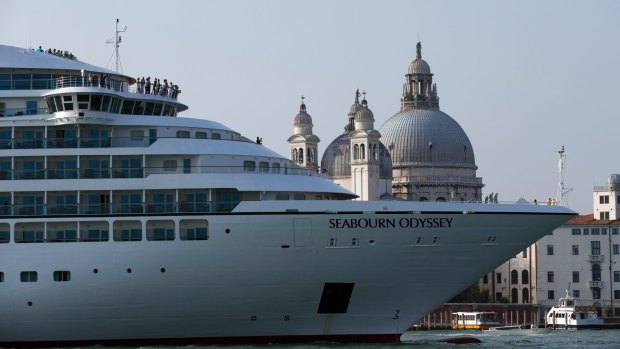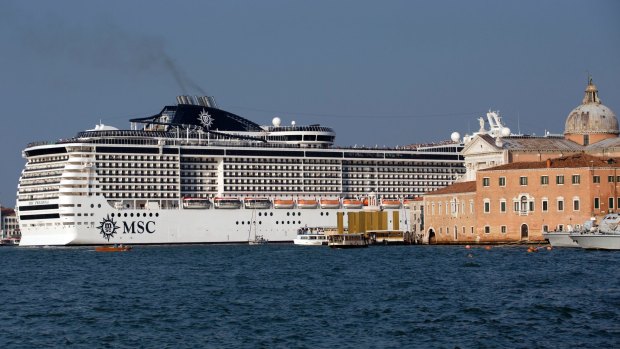This was published 6 years ago
Cruise ships in Venice: Italy votes to ban giant ships from canal
By JASON HOROWITZ

Venice has faced an onslaught of tourism that has challenged the city's character, clogged its narrow waterways and chased its local population away.Credit: AP
Away from the throngs of disembarked day trippers marching under selfie-stick bayonets along the Grand Canal in Venice, the headquarters of the No Big Ships Committee has long displayed posters and T-shirts depicting giant cruise ships as sharks threatening to devour gondoliers, fishermen and the city itself.
On Tuesday, officials in Rome voted to keep the sharks a little farther at bay.
A group of local, provincial and national officials approved, after years of debate, a plan to divert large cruise ships weighing more than 87,000 tonnes farther from St. Mark's Square, the Grand Canal, the Ducal Palace and other Venetian treasures.

FILE - In this Sept. 27, 2014 file photo a cruise ship transits in the Giudecca canal, in The Italian government and Venice officials will to block giant cruise ships from steaming past the city's iconic St. Mark's Square and instead re-route them to a nearby industrial port. Credit: AP
Instead of cruising down the Giudecca Canal, the large ships will be required to take a more roundabout path, through a nearby canal and up to a passenger port to be built in Marghera, an industrial area of the Venetian mainland.
"We have found a real solution," Graziano Delrio, the transport and infrastructure minister, said in a statement after the meeting in Rome. "No more big ships."
Some questioned whether the deal would come to fruition. To the horror of historians, environmental campaigners and the remaining few Venetian natives, Venice seems to be preparing for even bigger ships. The authorities expect cruise liners to get even larger, and the proposed port would accommodate them.
Venice has faced an onslaught of tourism that has challenged the city's character, clogged its narrow waterways and chased its local population away. There emerged no clearer symbol for the invasion of tourists than the cruise ships drifting, lunar-like, through the lagoon. They eclipsed church towers, famous views and, occasionally, the sun.
See also: We're sick of you: The hotspot cities that now hate tourists
Even as tourist traps depended on the big ships for a new supply of consumers, locals cursed the sight of them and the Italian minister of culture and tourism, Dario Franceschini, who participated in the meeting, called them a "problem."
The local authorities are hailing the new rules as a feat of compromise. They say they have addressed the concerns of residents, the requirements of shops and restaurants that live off cruise ship tourism, and answered the alarms raised by conservation groups who argue that the ships wreak havoc on the city's already fragile and damaged lagoon.
The mayor, Luigi Brugnaro, said the decision made it clear to "the whole world that we have a solution." Sounding a bit like a Venice travel agent, he added, "We can start to work seriously on planning cruises."
That planning will move at a cruise ship's pace, as government officials have given themselves four years to map a new route and build the port. In addition, Venice has imposed bans on some ships from the Giudecca Canal in the past, only to reverse itself. But Delrio nevertheless called the decision a concrete solution that would not interfere with commercial routes around the city.
Smaller ships, weighing 50,000 to 87,000 tonnes, will still be allowed to rock the gondolas in the heavily trafficked portions of the lagoon.
Those vessels, not to mention the larger ones that will be diverted by the new rules, still pose too great a risk for defenders of the city's cultural heritage and environmentalists, who note the damage that cruise ships cause to the lagoon's ecosystem and foundation.
The big ships, and the bigger ones to come, are seen by opponents as sea monsters that they can barely bring themselves to imagine.
Tommaso Cacciari, a spokesman for the No Big Ships Committee, called the decision on Tuesday a "fantasy" and expressed doubts that the environmental authorities would allow the expansion of an already existing canal that is crucial to the project.
"They have decided nothing," he said, "and in the meantime, the ships will keep passing in front of San Marco."
The only solution, he added, was the one his group has long advocated: "The big ships need to stay out of the lagoon," he said.
The New York Times
See also: Ripped off: Anger after tourist cops $797 bill for lunch in Venice
See also: The 20 must-do highlights of Venice
Sign up for the Traveller Deals newsletter
Get exclusive travel deals delivered straight to your inbox. Sign up now.